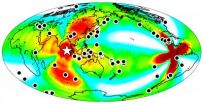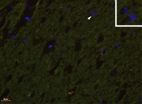(Press-News.org) This year's largest earthquake, a magnitude 8.6 temblor on April 11 centered in the East Indian Ocean off Sumatra, did little damage, but it triggered quakes around the world for at least a week, according to a new analysis by seismologists from the University of California, Berkeley, and the U.S. Geological Survey (USGS).
The April 11 quake was unusually large – the tenth largest in the last 100 years and, similar to a few other recent large quakes, triggered small quakes during the three hours it took for seismic waves to travel through Earth's crust.
The new study shows, however, that some faults weren't rattled enough by the seismic waves to fail immediately, but were primed to break up to six days later.
The findings are a warning to those living in seismically active regions worldwide that the risk from a large earthquake could persist -- even on the opposite side of the globe -- for more than a few hours, the experts said.
"Until now, we seismologists have always said, 'Don't worry about distant earthquakes triggering local quakes,'" said Roland Burgmann, professor of earth and planetary science at UC Berkeley and coauthor of the study. "This study now says that, while it is very rare – it may only happen every few decades – it is a real possibility if the right kind of earthquake happens."
"We found a lot of big events around the world, including a 7.0 quake in Baja California and quakes in Indonesia and Japan, that created significant local shaking," Burgmann added. "If those quakes had been in an urban area, it could potentially have been disastrous."
Burgmann and Fred F. Pollitz, Ross S. Stein and Volkan Sevilgen of the USGS will report their results online on Sept. 26 in advance of publication in the journal Nature.
Burgmann, Pollitz, a research seismologist, and their colleagues also analyzed earthquake occurrences after five other recent temblors larger than 8.5 – including the deadly 9.2 Sumatra-Andaman quake in 2004 and the 9.0 Tohoku quake that killed thousands in Japan in 2011 – but saw only a very modest increase in global earthquake activity after these quakes. They said this could be because the East Indian Ocean quake was a "strike-slip" quake that more effectively generates waves, called Love waves, that travel just under the surface and are energetic enough to affect distant fault zones.
Burgmann explained that most large quakes take place at subduction zones, where the ocean bottom sinks below another tectonic plate. This was the origin of the Sumatra-Andaman quake, which produced a record tsunami that took more than 200,000 lives. The 2012 East Indian Ocean quake involved lateral movement – referred to as strike-slip, the same type of movement that occurs along California's San Andreas Fault – and was the largest strike-slip quake ever recorded.
"This was one of the weirdest earthquakes we have ever seen," Burgmann said. "It was like the 1906 San Francisco earthquake, a strike-slip event, but it was huge – 15 times more energetic. This earthquake and an 8.3 that followed were in a very diffuse zone in an oceanic plate close to the Sumatra subduction zone, but it wasn't a single fault that produced the quake, it was a crisscrossing of three or four faults that all ruptured in sequence to make such a big earthquake, and they ruptured deep."
The seismologists analysis found five times the expected number of quakes during the six days following the April 11 quake and aftershock. An unusually low occurrence of quakes during the 6-12 days before that 8.6 quake may have accentuated the impact, possibly because there were many very-close-to-failure faults sensitive to a triggering shock wave, Pollitz said.
One possible mechanism for the delayed action, Burgmann said, is that the East Indian Ocean quake triggered a cascade of smaller, undetectable quakes on these faults that led to larger ruptures later on.
Alternatively, large quakes could trigger nearly undetectable tremors or microquakes that are a sign of slow slip underground.
"One possibility is that the earthquake immediately triggers slow slip in some places, maybe accompanied by detectable tremor, and then that runs away into a bigger earthquake," Burgmann speculated. "Some slow slip events take days to a week or more to evolve."
INFORMATION:
The work was supported by the USGS.
Large 2012 earthquake triggered temblors worldwide for nearly a week
8.6 magnitude quake primed some distant faults to rupture days later
2012-09-27
ELSE PRESS RELEASES FROM THIS DATE:
Cannabis withdrawal symptoms might have clinical importance
2012-09-27
Cannabis users have a greater chance of relapse to cannabis use when they experience certain withdrawal symptoms, according to research published Sep. 26 in the open access journal PLOS ONE led by David Allsop of the National Cannabis Prevention and Information Centre (NCPIC) at the University of New South Wales.
The authors tested a group of dependent cannabis users over a two week period of abstinence for impairment related to their withdrawal symptoms. Findings were correlated with the probability of relapse to cannabis use during the abstinence period, and the level ...
First evidence of fetal DNA persisting in human brain tissue
2012-09-27
Small portions of male DNA, most likely left over in a mother's body by a male fetus can be detected in the maternal brain relatively frequently, according to a report published Sep. 26 in the open access journal PLOS ONE by William Chan of Fred Hutchinson Cancer Research Center and his colleagues.
The process, called fetal 'microchimerism (Mc)', is common in other tissues such as blood, but this is the first evidence of male Mc in the human female brain. Microchimerism can be both beneficial and harmful to maternal health, since it is associated with processes such ...
Viewing gender-specific objects influences perception of gender identity
2012-09-27
Spending too much time looking at high heels may influence how a viewer perceives the gender of an androgynous face, according to new research published Sep. 26 in the open access journal PLOS ONE by Amir Homayoun Javadi of Technische Universität, Dresden and his colleagues. The study sheds new light on how the objects surrounding us may influence our perceptions of gender.
The authors found that when people view objects highly associated with one gender, like high heels for women or electric shavers for men, for a short period of time and are then asked to identify the ...
Psychology of equine performance and the biology behind laminitis
2012-09-27
Achieving the best performance from a horse is the goal of not just professional riders, but also the millions of amateur and hobby riders all over the world. A new article published in BioMed Central's open access journal BMC Veterinary Research looks at the issues surrounding training, competition environment and practices, and how the psychology of horse mood, emotion and temperament can be used to enhance performance. A sister article looks at the devastating disease laminitis, and finds that the anti-inflammatory protein apolipoprotein A-IV (APOA-IV) is raised in chronic ...
Scientists make old muscles young again in attempt to combat aging
2012-09-27
An international team of scientists have identified for the first time a key factor responsible for declining muscle repair during ageing, and discovered how to halt the process in mice with a common drug. Although an early study, the findings provide clues as to how muscles lose mass with age, which can result in weakness that affects mobility and may cause falls.
The study, to be published in the journal Nature, involved researchers from King's College London, Harvard University and Massachusetts General Hospital.
The study looked at stem cells found inside muscle ...
TB drug could reduce mortality for MDR-TB and XDR-TB cases
2012-09-27
Results from an observational study evaluating a new anti-TB drug have found that the treatment can improve outcomes and reduce mortality among patients with both MDR-TB and XDR-TB.
The research, published online ahead of print today (27 September 2012) in the European Respiratory Journal, suggests a drug called delamanid could have a public health benefit for MDR-TB and also for XDR-TB, as few effective treatment options are currently available.
Over the past two decades, multidrug-resistant TB (MDR-TB) has emerged as a significant public health threat, with strains ...
Salt marsh carbon may play role in slowing climate warming, study shows
2012-09-27
A warming climate and rising seas will enable salt marshes to more rapidly capture and remove carbon dioxide from the atmosphere, possibly playing a role in slowing the rate of climate change, according to a new study led by a University of Virginia environmental scientist and published in the Sept. 27 issue of the journal Nature.
Carbon dioxide is the predominant so-called "greenhouse gas" that acts as sort of an atmospheric blanket, trapping the Earth's heat. Over time, an abundance of carbon dioxide can change the global climate, according to generally accepted scientific ...
WSU study finds dioxin causes disease and reproductive problems across generations
2012-09-27
PULLMAN, Wash.—Since the 1960s, when the defoliant Agent Orange was widely used in Vietnam, military, industry and environmental groups have debated the toxicity of its main ingredient, the chemical dioxin, and how it should be regulated.
But even if all the dioxin were eliminated from the planet, Washington State University researchers say its legacy will live on in the way it turns genes on and off in the descendants of people exposed over the past half century.
Writing in the journal PLoS ONE, biologist Michael Skinner and members of his lab say dioxin administered ...
Inadequate cellular rest may explain effects of aging on muscles
2012-09-27
Is aging inevitable? What factors make older tissues in the human body less able to maintain and repair themselves, as in the weakening and shrinkage of aging muscles in humans? A new study from Massachusetts General Hospital (MGH) investigators and collaborators at King's College London describes the mechanism behind impaired muscle repair during aging and a strategy that may help rejuvenate aging tissue by manipulating the environment in which muscle stem cells reside. The report will appear in the journal Nature and has received advance online release.
Rare muscle ...
Gut bacteria could cause diabetes
2012-09-27
VIDEO:
Studying gut bacteria can reveal a range of human illness. Now, new research shows that the composition of a person’s intestinal bacteria could play an important role in the development...
Click here for more information.
The number of people suffering from type 2 diabetes world-wide has risen rapidly in recent years, and scientists estimate that just as many people could be suffering from the illness without realising it. New research now indicates that your gut bacteria ...
LAST 30 PRESS RELEASES:
Longest observation of an active solar region
Why nail-biting, procrastination and other self-sabotaging behaviors are rooted in survival instincts
Regional variations in mechanical properties of porcine leptomeninges
Artificial empathy in therapy and healthcare: advancements in interpersonal interaction technologies
Why some brains switch gears more efficiently than others
UVA’s Jundong Li wins ICDM’S 2025 Tao Li Award for data mining, machine learning
UVA’s low-power, high-performance computer power player Mircea Stan earns National Academy of Inventors fellowship
Not playing by the rules: USU researcher explores filamentous algae dynamics in rivers
Do our body clocks influence our risk of dementia?
Anthropologists offer new evidence of bipedalism in long-debated fossil discovery
Safer receipt paper from wood
Dosage-sensitive genes suggest no whole-genome duplications in ancestral angiosperm
First ancient human herpesvirus genomes document their deep history with humans
Why Some Bacteria Survive Antibiotics and How to Stop Them - New study reveals that bacteria can survive antibiotic treatment through two fundamentally different “shutdown modes”
UCLA study links scar healing to dangerous placenta condition
CHANGE-seq-BE finds off-target changes in the genome from base editors
The Journal of Nuclear Medicine Ahead-of-Print Tip Sheet: January 2, 2026
Delayed or absent first dose of measles, mumps, and rubella vaccination
Trends in US preterm birth rates by household income and race and ethnicity
Study identifies potential biomarker linked to progression and brain inflammation in multiple sclerosis
Many mothers in Norway do not show up for postnatal check-ups
Researchers want to find out why quick clay is so unstable
Superradiant spins show teamwork at the quantum scale
Cleveland Clinic Research links tumor bacteria to immunotherapy resistance in head and neck cancer
First Editorial of 2026: Resisting AI slop
Joint ground- and space-based observations reveal Saturn-mass rogue planet
Inheritable genetic variant offers protection against blood cancer risk and progression
Pigs settled Pacific islands alongside early human voyagers
A Coral reef’s daily pulse reshapes microbes in surrounding waters
EAST Tokamak experiments exceed plasma density limit, offering new approach to fusion ignition
[Press-News.org] Large 2012 earthquake triggered temblors worldwide for nearly a week8.6 magnitude quake primed some distant faults to rupture days later



